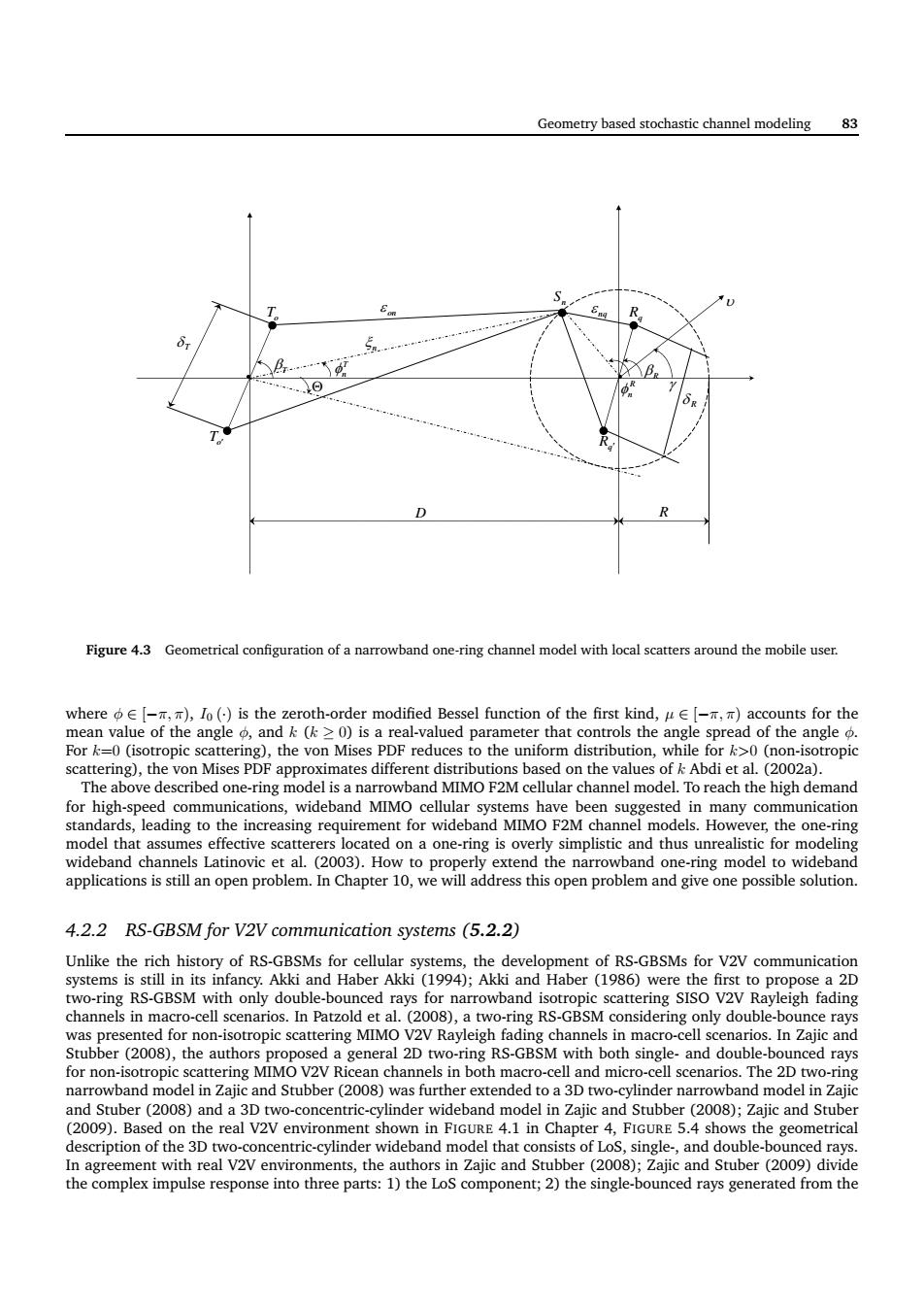正在加载图片...

Geometry based stochastic channel modeling 83 Figure 4.3 Geometrical rion of a narrowband one-ring channel model with local scatters around the mobile user. that controls the a ngle spread of the angle tropic model that assumes effective scatterers located on a one-ring is overly simplistic and thus unrealistic for modelin 4.2.2 RS-GBSM for V2V communication systems(5.2.2) wortgRs-GBsMwithomydoubletbonoedaonarotandotoptcCaeringsS0V2yRalehading nels MIMO V2V Rayl cha ing only double )the posed a genera .and double-bounced rays and Stuber(2008)and a 3D two-concentric-cylinder wideband model in Zajic and Stubber(2008);Zajic and Stuber real .in( e FIGURE 5.4 ent with real V2V environments,the authors oS component;2)the single-bou rays generated from theGeometry based stochastic channel modeling 83 Rq n X S To Toc Rqc on H nq H n [ D R T In R In J E R E T G T G R 4 Figure 4.3 Geometrical configuration of a narrowband one-ring channel model with local scatters around the mobile user. where φ ∈ [−π, π), I0 (·) is the zeroth-order modified Bessel function of the first kind, µ ∈ [−π, π) accounts for the mean value of the angle φ, and k (k ≥ 0) is a real-valued parameter that controls the angle spread of the angle φ. For k=0 (isotropic scattering), the von Mises PDF reduces to the uniform distribution, while for k>0 (non-isotropic scattering), the von Mises PDF approximates different distributions based on the values of k Abdi et al. (2002a). The above described one-ring model is a narrowband MIMO F2M cellular channel model. To reach the high demand for high-speed communications, wideband MIMO cellular systems have been suggested in many communication standards, leading to the increasing requirement for wideband MIMO F2M channel models. However, the one-ring model that assumes effective scatterers located on a one-ring is overly simplistic and thus unrealistic for modeling wideband channels Latinovic et al. (2003). How to properly extend the narrowband one-ring model to wideband applications is still an open problem. In Chapter 10, we will address this open problem and give one possible solution. 4.2.2 RS-GBSM for V2V communication systems (5.2.2) Unlike the rich history of RS-GBSMs for cellular systems, the development of RS-GBSMs for V2V communication systems is still in its infancy. Akki and Haber Akki (1994); Akki and Haber (1986) were the first to propose a 2D two-ring RS-GBSM with only double-bounced rays for narrowband isotropic scattering SISO V2V Rayleigh fading channels in macro-cell scenarios. In Patzold et al. (2008), a two-ring RS-GBSM considering only double-bounce rays was presented for non-isotropic scattering MIMO V2V Rayleigh fading channels in macro-cell scenarios. In Zajic and Stubber (2008), the authors proposed a general 2D two-ring RS-GBSM with both single- and double-bounced rays for non-isotropic scattering MIMO V2V Ricean channels in both macro-cell and micro-cell scenarios. The 2D two-ring narrowband model in Zajic and Stubber (2008) was further extended to a 3D two-cylinder narrowband model in Zajic and Stuber (2008) and a 3D two-concentric-cylinder wideband model in Zajic and Stubber (2008); Zajic and Stuber (2009). Based on the real V2V environment shown in FIGURE 4.1 in Chapter 4, FIGURE 5.4 shows the geometrical description of the 3D two-concentric-cylinder wideband model that consists of LoS, single-, and double-bounced rays. In agreement with real V2V environments, the authors in Zajic and Stubber (2008); Zajic and Stuber (2009) divide the complex impulse response into three parts: 1) the LoS component; 2) the single-bounced rays generated from the